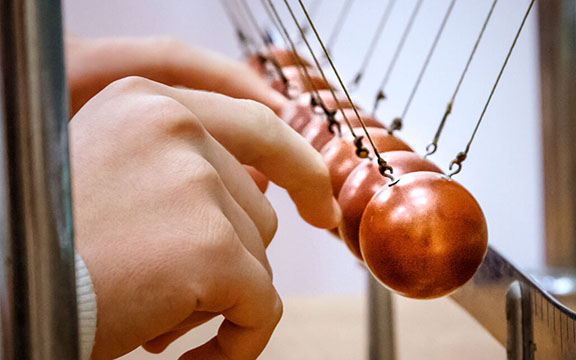 While the study of physics may sound a million miles away from Yoga, they actually have a very close relationship. From energy to forces, physics plays a part in all areas of Yoga practice. When teaching classes, I like to bring in the idea that our actions are not happening in a vacuum. There are invisible forces, waves and vibrations all around us! A lovely example of this is Newton’s Third Law of Motion, which states that for every action there is an opposite and equal reaction. While, this may at first glance seem to have nothing to do with Yoga, it can be applied to two very familiar asanas.
While the study of physics may sound a million miles away from Yoga, they actually have a very close relationship. From energy to forces, physics plays a part in all areas of Yoga practice. When teaching classes, I like to bring in the idea that our actions are not happening in a vacuum. There are invisible forces, waves and vibrations all around us! A lovely example of this is Newton’s Third Law of Motion, which states that for every action there is an opposite and equal reaction. While, this may at first glance seem to have nothing to do with Yoga, it can be applied to two very familiar asanas.
When we take Cat/Cow pose (marjaryasana/bitilasana) and choose to mindfully push our hands, shins and tops of the feet into the ground, the earth will push back with the same force. This is the opposite and equal reaction. We can let the feeling of this force travel up our limbs and use it to maximize the flexion, or forward bend cat stretch, of our spine. We are literally drawing forces from the earth to help us in our movements.
The Earth’s atmospheric pressure is another area of physics that we use unknowingly in Yoga. Pranayama often involves mindful inhaling and exhaling, but the cleansing kapalabhati (skull shining breath) focuses on the exhale only. How can we not need to inhale in this breath? The answer lies in the atmospheric pressure all around us. When we have exhaled and the diaphragm moves down and intercostal muscles move out, the chest volume increases and pressure decreases, as Boyle’s law states, the pressure of a gas tends to decrease as the volume of the container increases. Air moves from high to low pressure, therefore our inhale happens automatically. The atmosphere breathes for us!
This could be the reason that many people tend to find kumbhaka (breath retention) more challenging after an inhale (antara) than after an exhale (bahya), as the air wants to find its way in to equalize the pressure. Staying with the idea of breath, have you ever noticed that kind of buzzing energy vibration during or immediately after practicing the ‘bee breath’ of brahmari? It’s not in your imagination, it’s actually happening! Sound travels by vibrating from the source of the sound and bumping into the air molecules around, these then bump into their neighbors and this pattern continues, making sound waves or sound energy. When sound energy travels through the air and reaches our eardrum, it makes that vibrate too, allowing us to hear the sound. When this happens we may also feel that buzzing sense of energy vibration too.
Now let’s consider gravity. It’s not something that we may usually be aware of, but when we understand the effects it can have on our practice, it can transform how we experience it. The force of gravity is everywhere, it keeps the planets orbiting around the sun and also keeps objects and us from floating around uncontrollably, by pulling objects towards one another.
Developing awareness that there is a force that holds us safely to the Earth can allow tadasana (mountain pose) to feel like our feet are being firmly held on the mat. This also works for savasana (corpse pose), as we lay down, we can purposely surrender all our weight to the force of gravity and know that we will be safely held by the Earth. This can give poses a real sense of grounding.
We can also consider our center of gravity (COG), which is thought to be the point where gravity acts on the body. The taller we are, the higher our centre of gravity. When we adopt poses, such as garland pose (malasana), often called Yoga squat, we lower our centre of gravity. A lower COG increases balance and stability in the body. Any poses where we have bent knees or take our weight lower to the ground should feel more stable. This is another way we can make these forces work with our bodies to take our practice to another level.
We can also defy gravity, by taking inversions, where our head is taken below our heart and hips. In poses such as downward facing dog (adho mukha svanasana), we are using our strength to push the hips and body away from the force of gravity. This can mean that we need to work quite hard to maintain the pose for any length of time, increasing our strength and muscle which can, among other things, help to reduce the risk of injury.
However, gravity doesn’t mean that all inversions have to be hard work. In fact, gravity can have wonderfully beneficial effects for our heart health with no effort required! When practicing legs up the wall pose (viparita karani), a favorite of restorative classes, gravity helps our circulating blood to return to the heart. When we are upright, the heart has to work harder to bring the blood back from our legs as it is working against gravity, with our legs up the wall, gravity works for us. This allows the heart to not work as hard, which in turn decreases our blood pressure, lessening our risk of heart-related issues.
So next time you lay out your mat, you may want to take a moment to consider how the invisible forces, energy and waves all around you are silently influencing your Yoga practice.
About the Author:
 Vicky Richings, founder of Equanimity Yoga and EQYoga Training, is an experienced, 500-hour qualified Yoga teacher, educator, mentor and YTT tutor.
Vicky Richings, founder of Equanimity Yoga and EQYoga Training, is an experienced, 500-hour qualified Yoga teacher, educator, mentor and YTT tutor.
(Reprinted from Om Yoga & Lifestyle magazine)

